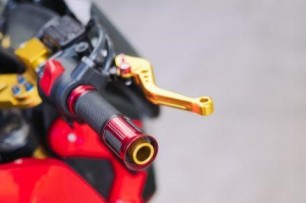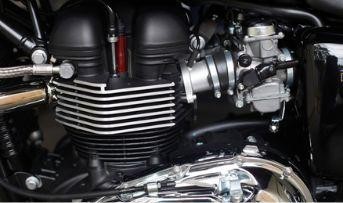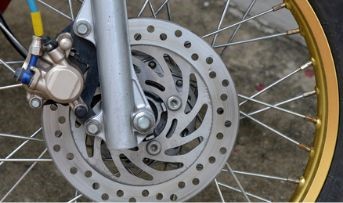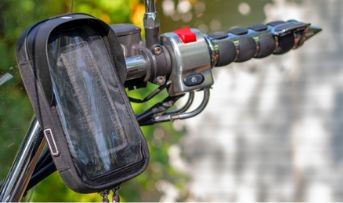General Insurance Blogs, Articles & Updates by - Magma HDI
Have us call you
- RENEW YOUR POLICY
- BUY NEW POLICY

These drive-away destinations make for a dreamlike weekend getaway
Have you ever felt unproductive while having tight deadlines and no creativity or motivation to complete your tasks? You may be facing burnout and are among 40% of the Indian workforce. While it may seem challenging to get out of such a phase, the best way to overcome the symptoms of burnout is to step away from work and hit refresh! What better way to do so than going on a short vacation?
Considering the intense work pressure and hectic schedules, taking a leave may not always be possible. So why not make the best use of your weekends to drive away from monotony? Short road trips are the perfect way to meet your requirements without overspending. Considering the traffic-packed roads across the country, taking your bike on the journey may be ideal.
If you’re convinced, pack light, gather your friends, get your bike serviced, ensure all the papers are in order, and purchase two wheeler insurance online India. Pick a destination from our specially curated list to experience the joy of a quick getaway over the weekend!
1. Cherrapunji, Meghalaya:
Known as a quaint town, the wettest place on Earth is home to unique living root bridges that you must check out. With well-built expressways through scenic greenery, motorcyclists are in for a joy ride on this journey. We recommend starting from Guwahati or Shillong to experience the best of the town’s old-world charm.
2. Goa:
Planning a vacation without mentioning Goa, irrespective of duration, is impossible. With excellent connectivity to neighbouring states, the party capital is the best place to head to if you need tranquillity or happening parties. The ride through the picture-perfect Konkan belt will stay in your memories forever!
3. Ooty:
The rolling hills of Ooty and its lush greenery make for a serene getaway. Enjoy the view of far-reaching sprawling tea and coffee plantations as you drive through valleys on meandering roads.
4. Jaisalmer:
If rough terrains excite the motorcyclist in you, Rajasthan’s cities are the perfect destinations to plan your next road trip. A panoramic view of the beautiful blend of culture, heritage, and vibrancy will follow you as you make your way to the Golden City. Considering the arid surroundings, planning your trip between November and March is suggested. We urge you to purchase two wheeler insurance online India to cover any mishaps you may encounter during your journey.
5. Araku Valley:
At a little over a hundred kilometres away from the City of Vishakhapatnam is Araku Valley, a hill station with rustic heritage, tribal influence, and coffee plantations. While the journey may be short, the valley offers the best nature, biodiversity, and climate, making for a refreshing retreat.
6. Munnar:
If you fancy long-distance road trips, plan your next trip to Munnar, a hill station in Kerala. Its green hills, waterfalls, and tea plantations make for the perfect view on your journey, which may take up to 04 hours if you start from Kochi.
The other popular destinations include Lonavala, Karjat, Alibag, Nasik, Daman, etc. which promise a happening weekend setting for you to unwind and return with positivity and energy.
This list is not exhaustive and only includes some destinations you can consider setting off. While each destination has a unique appeal, we urge you to purchase two wheeler insurance online India before you depart on your two-day vacation! Safety should always be on top while planning bike trips. Wear proper gear and a helmet to safeguard yourself from any mishap.
Click HERE to buy two wheeler insurance online India.
Disclaimer: The information provided above is for illustrative purposes only. To get more details, please refer to policy wordings and prospectus before purchasing a policy.

These are a few ways you can detect bad clutch problems in your bike
Riding a motorbike with smooth-shifting gears gives you a sense of pleasure that no other thing can. The feeling of downshifting into a curve, soaring your RPMs, then switching back into high and rushing down the straightaway is unmatched.
But when the quality of your clutch starts deteriorating, it no longer grips as usual or allows you to smooth down and upshift. If you take too much time to assess a bad clutch, it might leave you stranded during a ride. While the rest of the crew enjoy the journey, you will have to spend extra time repairing or replacing it.
However, knowing the signs of a damaged clutch will help you repair the appropriate pieces before you're left stranded.
In today's post, we'll discuss ways to assess if your clutch is on its way to being damaged. Read along to know how you can avoid costly repairs before it's too late.
1. Slipping of clutch:
The clutch slipping indicates that it has already begun to wear down. You may sense a lag or a slight jerk when your bike starts picking up. The RPM starts to increase faster than it should. If any of these occur, your bike's clutch is worn out, and it's time to get it repaired.
2. Sticking of clutch:
Your bike's clutch will start to stick if there is a malfunction or oil-induced dirt in the springs. It can either stick in or out depending on when the event occurs. The clutch parts will cling together as you change gears resulting in a low-power transmission. A sticky clutch might be mistaken for a general bike problem, so be extra cautious and get it diagnosed.
3. Hard to shift gears:
If your clutch wire is loose or the clutch gap is compressed, the bike will not accelerate because you won't be able to shift gears. When parking your bike, it's best to keep it in neutral, although some people leave it in first gear. So if you ever experience a slack in shifting gears, visit the mechanic.
Tip: To minimise clutch dislocation and overheating, always start your bike in neutral. Overheating the metal components causes them to expand, lowering the spacing distance. However, the clutch relies on friction to transfer power, so oil the parts regularly to avoid overheating.
4. Sharp metallic noise:
If you've recently noticed a strange sound emanating from your bike and it becomes louder as the days pass, it might be your clutch asking for attention.
5. Burning smell:
A burning odour may signal a clutch problem, which you should not neglect. If a mechanical noise accompanies the smell, you should have the clutch pad checked out as soon as possible to avoid any more damage.
These are some ways you can detect a problem with your clutch system. Make sure you always park your bike on neutral. Oil the clutch system periodically, but don't put too much oil. Never use the clutch as the braking alternative unless it's very needful, like in case of brake failures.
While you ensure your clutch pad, insure your bike as well, it will help you in case of mechanic visits for your clutch repairs and avoid additional expenses. Purchase bike insurance online and add value to your two-wheeler with the benefits of comprehensive coverage.
Click HERE to get the best bike insurance online right now.
Disclaimer: The information provided above is for illustrative purposes only. To get more details, please refer to policy wordings and prospectus before purchasing a policy.

Your bike’s cubic capacity can directly impact its insurance premium, here’s all you need to know
Manufacturing date, location, vehicle model, claims history with add-ons, and optional deductibles are a few variables that could impact your bike insurance. However, some other aspects could also influence the cost of insurance.
An essential factor in calculating the insurance premium is the two-wheeler's cubic capacity (cc), also known as its engine capacity. Continue reading to learn how your bike's cubic capacity affects its insurance cost.
What is the cubic capacity of a bike?
The capacity of your bike's engine is measured by its cc i.e., cubic capacity. A bike's engine size is essential since it affects how much power it can produce. A two-wheeler is thought to be stronger if its chamber is larger. Similar to how a four-wheeler vehicle's engine capacity is expressed in litres, a bike's capacity is understood similarly.
Bikes with higher cubic capacity come equipped with large cylinders that can produce extensive power output from the engine. This results in low fuel efficiency as more consumption is observed to drive more engine power output per stroke.
Bikes with higher cubic capacities are expensive. This is because intense mechanical fitness and build are required for the bike to withstand tremendous torque and power. Higher cc bikes have premium quality brake pads, comfortable suspension, and excellent exhaust that can easily overcome the wear and tear that might result from high-speed riding.
What effect does your bike's cubic capacity have on policy premiums?
Your bike's engine power is critical in the premium fixing process. The engine's cubic capacity affects the cost of your motorcycle insurance. A 75 cc bike would be less expensive to insure than a 220 cc bike. Take proper care of your bike's engine to guarantee that it operates smoothly.
Higher cc bikes would cost more to insure because your insurance rate directly correlates to your engine's cubic capacity (cc). When determining the third-party insurance rate, the IRDAI primarily considers the cc of your bike.
A bike's cc majorly determines the on-road cost of the bike. Low-cc bikes are less expensive than high-cc ones. The insurance premium for expensive bikes is more, considering their superior build quality and use of costly parts.
Other elements that affect the insurance premium for bikes with the higher cubic capacity.
Here are the various factors that influence the premium of the higher cubic capacity bikes:
● Geographic location: Compared to Tier II cities or rural areas, the premium is more significant if you stay in a metropolitan metropolis. Compared to non-metro regions, urban areas have a higher risk factor.
● Year of production: The age of the vehicle directly affects the insured amount. The insurance sum will decrease as time goes on since the bike loses value.
● Make and model of the bike: Premiums for high-end/premium bikes are higher; premiums for entry-level bikes are lower.
● Add-ons: In return for a more premium for bikes with higher cubic capacity, add-ons safeguard you against situations that aren't covered by the basic program.
● Installation of security measures: Lowering the danger of theft and the likelihood of damage by installing anti-theft devices or other security measures reduces the insurance price. By installing security devices, you can get a reduction in insurance premiums for bikes with higher cubic capacity.
Every bike driven on the road must be covered by third-party insurance. Therefore, in addition to looking at the bike's qualities before buying one, you should also consider getting bike insurance. Shop around to buy motor insurance online that best suits your needs and expectations. You can reduce the cost of two-wheeler insurance while maintaining adequate coverage if you heed the above suggestions.
Click HERE to buy motor insurance online.
Disclaimer: The information provided above is for illustrative purposes only. To get more details, please refer to policy wordings and prospectus before purchasing a policy.

These advanced technologies are making motorcycle rides safer and how
The ever-increasing number of vehicles on Indian roads is constantly posing a risk to the safety of drivers, riders, and pedestrians. While purchasing the best two wheeler insurance in India is a mandatory requirement, several advanced technologies have also evolved to make motorcycle rides safer. These technologies are helping to reduce the number of accidents and enhancing road safety.
Let us have a look at them in detail.
1. Anti-lock braking system:
An anti-lock braking system or ABS is a technology that prevents a motorcycle’s wheels from locking when sudden brakes are applied. Hurried braking is usually used when an object or a vehicle appears suddenly in front of the bike. This may cause our motorcycle to skid and cause serious bodily injuries and even damage to the bike.
ABS makes use of speed sensors that are fitted on both wheels. It senses that a wheel lockup is about to occur and instantly reduces brake pressure. This prevents the motorcycle from skidding, preventing an accident.
2. Wearable airbags:
We have always known that cars come equipped with airbags that open up instantly at the time of a car crash. They minimise the impact of accidents and help to save lives. Most of us do not know that wearable airbags for bikes are now being made with the help of modern technology that performs a similar function as cars’ airbags at the time of a crash. Wearable airbags are put into a vest and can be worn with a compatible jacket. The airbag inflates during a collision and then deflates automatically. It cushions the rider and the pillion rider, minimising the crash's impact. These airbags can be a lifesaver and protect the upper half of the body. Also, these airbags are universal in nature and can be used with any motorcycle make and model.
3. Motorcycle alert systems:
Modern technology has enabled the incorporation of radar sensors that can scan our surroundings and identify potential dangers, even in motorcycles. These sensors can help us map the vehicles around us and alert us of any possible collision. They can also warn us of approaching vehicles or if a vehicle gets too close to us.
Motorcycles nowadays also come with sensors that alert us if our kickstand or side stand is open by flashing a light on the display panel. This helps avert a possible crash due to the open kickstand while riding.
4. Advanced lighting:
Motorcycles now have advanced LED lighting systems that produce optimal beams for enhanced street visibility. This minimises the chances of an accident due to poor visibility on the streets at night or during heavy fog conditions. Also, motorcycles have hi-technology illumination systems that enhance their visibility in poor light conditions.
5. Modern helmets:
Helmets are being made with advanced technology, making them lighter and sturdier. Modern-day helmets make our rides safer and protect our heads better than older models of helmets at the time of a crash.
Helmets nowadays also come equipped with hi-tech Bluetooth headsets and good-quality cameras. They help bikers stay connected during a ride, especially in difficult and risky terrains. The cameras are capable of capturing minute details during a ride. Riders can go through the recordings after finishing their ride and make a note of the possible improvements.
Modern technology is a blessing in reducing the number of road accidents. These innovations might cost us money, but they are worth every penny spent on them as they reward us with a safe journey. Two wheeler insurance also makes our motorcycle rides safer by protecting us financially in case of a crash. Choose the best two wheeler insurance in India to ensure complete motorcycle coverage and hassle-free claim settlement in times of need.
Click HERE to buy the best two wheeler insurance in India.
Disclaimer: The information provided above is for illustrative purposes only. To get more details, please refer to policy wordings and prospectus before purchasing a policy.

Tips to renew the vehicle fitness certificate of your old two-wheeler
As two-wheelers turn old, their performance and the quality of their internal parts start to deteriorate. Significantly, the engine gets severely affected, which leads to more fuel consumption and harmful emissions. Such two-wheelers are then considered not fit to ride.
If you own an old two-wheeler and wish to ride it on Indian roads legally, then you need to have a fitness certificate for it. The Government of India has made the renewal of fitness certificates convenient by introducing the 'Parivahan Sewa portal' that operates entirely online.
Applying online is a hassle-free process as you only need to fill out a form and submit all the required documents to your local Regional Transport Office (RTO) for verification.
In today's post, we will take you through the step-by-step process of renewing your two-wheeler's fitness certificate online:
1. Go to the official VAHAN website. Begin the renewal process by going to 'Online Services' and selecting 'Vehicle Related Services.'
2. After that, choose your state. Next, click on 'Application for Fitness Certificate' and enter your bike's registration number and chassis number.
3. Following that, generate an OTP using your registered phone number. Enter the one-time password (OTP) that you received on your phone to proceed with the process.
4. Go to the 'Payment' option and complete the transaction to start the renewal fee transfer.
5. After completing these procedures, take the appropriate documentation to your local RTO to complete the two-wheeler fitness renewal process. Officials at the RTO will perform a fitness test on your bike and verify your documents to complete the process.
Steps to renew fitness certificate of two-wheeler offline.
Here is how you can acquire a fitness certificate for your bike offline:
1. Visit the local RTO
2. Fill out an application for a fitness certificate renewal
3. After that, attach the required documents to the application
4. To finish the procedure, pay the RTO the renewal fee for your bike fitness certificate
The officers will review your submitted documents and schedule an appointment for your bike's inspection. You must arrive at the designated centre on time. Here, your two-wheeler will be thoroughly investigated, and if it qualifies the desired parameters, you will be issued the fitness certificate for your bike.
Note: Although the renewal process is the same for both two and four-wheelers, the fee differs for both types of vehicles.
Complete list of documents you will require:
• Tax token
• Registration certificate
• Vehicle permit
• Pollution Under Control Certificate or PUCC
• Valid two-wheeler insurance policy papers
• Passport size photo
According to the Motor Vehicles Act of 1989, a vehicle's registration is only acceptable if a valid Vehicle Fitness Certificate accompanies it. Commercial and private automobiles are required by law to have a fitness certificate. Failing to submit a fitness certificate carries a punishment of Rs. 100. For consecutive violations, the fine is increased to Rs. 300. If you don't have a valid fitness certificate, you'll be fined between Rs. 2,000 to 5,000.
The law also mandates two wheeler insurance India. Failing to have both these documents can lead to hefty fines. Save yourself from the trouble and get the fitness certificate and insurance today. You can only enjoy riding your two-wheeler if you keep the required documents up-to-date and avoid landing yourself in any unwanted trouble.
Click HERE to buy the best two wheeler insurance India.
Disclaimer: The information provided above is for illustrative purposes only. To get more details, please refer to policy wordings and prospectus before purchasing a policy.

Wondering why your motor insurance premium is so high? Fuel may be the reason
While electric vehicles are capturing the vehicle market, petrol and diesel-based cars still need to be put in trend. Maximum Indian citizens today own fuel-based vehicles, be it two-wheeler or a four-wheeler. But these fuel-based cars also have a history of superseding one another. Petrol cars have always been the favoured alternative amongst fuel-based vehicles.
Initially, diesel usage focused on heavy vehicles operated for commercial purposes like duty trucks, etc. But with the advancement of technology today, diesel vehicles have become widely popular and opted for daily use vehicles like passenger cars.
But do you know that your motor insurance premium changes for the type of car you use? Fuel may be the reason. Want to know how? Without any further delay, let’s get started.
1. How much is your car’s price:
Diesel-powered and petrol-powered cars are priced differently in the Indian market. Usually, the price of vehicles that have diesel-powered engines is high when compared to their petrol-powered counterparts. A higher price directly reflects on the motor insurance and premium prices.
Therefore, the more expensive a car you have, the higher the motor insurance premium you have to pay. So, figure out the maintenance and premium charges you will have to pay in the future and create a budget in advance so that you do not get surprises of additional premiums like motor insurance.
2. Repair influences the premium charges:
Yes! Even the cost of repair influences the motor insurance premium prices. The repair charges for diesel-based vehicles are much higher than those for petrol-based cars. Therefore, the company charges high premiums for your motor insurance to help cover the claims if you make any in the future. Similarly, if your car has expensive spare parts or is priced in the high-end range, the companies will charge you high motor insurance premiums.
This proves that fuel has a massive impact on premium charges. Having this information before you make any purchase will help you put things into perspective, especially budget-wise. Many factors should be considered when someone decides to purchase a car, one of which is the motor insurance, its premium charges, claims, add-ons, and other features which vary from one insurance provider to another.
3. Is your car fuel efficient:
Fuel efficiency is another influencing factor that determines higher motor insurance premiums. While petrol-powered cars have great starting and ignition power, diesel-based cars are beneficial for vehicles purchased to last longer.
4. Let’s have a look at the engine:
The engine capacity of your petrol-powered car is lesser than that of diesel-based cars, thus raising the motor insurance premium prices for diesel-powered vehicles. The better the engine capacity, the higher the premium. Who knew that fuel could be such a powerful influencing factor in the premium prices of motor insurance?
5. Cannot miss IDV (Insurance Declared Value):
If the market value estimation is high, the IDV will be increased, directly impacting the premium. Usually, the IDV of diesel-based cars is high, which leads to a rise in premium prices.
We hope this blog gives you a crisp and clear idea about your motor insurance premium charges. This will help you arrive at a decision or educate you about motor insurance and what factors impact the premiums which will come out of your pocket. And there is no doubt about how crucial it is to purchase motor insurance to protect your car and yourself against the financial burden.
Click HERE to learn more about motor insurance.
Disclaimer: The information provided above is for illustrative purposes only. To get more details, please refer to policy wordings and prospectus before purchasing a policy.

The only one-stop guide for motorcycle accessories you must always carry
When it comes to motorcycles, many accessories can enhance your riding experience. Whether a seasoned rider or a beginner, carrying certain accessories can significantly improve your comfort and safety. When you have the proper accessories, riding a motorbike is an exhilarating, even more, pleasurable experience.
This blog will discuss the one-stop guide for motorcycle accessories you must always carry. Without any further delay, let's get started. The following list of some essential motorbike accessories should be on your must-have accessories list.
1. Reduce the minor vibrations through hand grips:
Hand grips seem like a small addition, but they can significantly enhance your riding experience. Do you know how annoying vibrations on your handlebars are; maybe you've ever felt them. A nice set of hand grips can lessen vibrations and improve the smoothness of your riding.
2. Protect your motorcycle using disc brakes:
You worry about someone taking your motorcycle when you leave it parked in an isolated location. A disc brake lock can add a level of security for you. Although some might counter that disc brake locks can be broken, having an extra layer of protection helps prevent burglars. A disc brake lock that beeps if someone tries to tamper with it can also be a good option.
3. Use your phone conveniently with a phone holder with a charger:
A motorcycle phone holder is essential for riders who want to use GPS properly while riding. A sturdy phone holder with a charger helps you to navigate your route without taking your hands off the handlebars. You may use this holder to mount your phone and access GPS.
4. Safeguard your shoe for the convenient operation of your motorcycle by using a proper gear shift pad: The lack of proper rubber padding on gear change levers might cause long-term damage to your shoes. Your shoes will be protected and last longer if you use a rubber gear shift pad. Choose a shift sock that you may place on the gear lever if you do not want to wear the shoe pad.
5. Pack your things in a motorcycle tank bag:
Carrying small items while riding is inconvenient, but a tank bag can help. It would be best to consider using the Tank Bag to transport your goods. It features a clear map pocket where you can keep your phone. The material is sturdy and durable and comes at pocket-friendly prices, so you don't burn through your savings.
6. Purchase cleaner and chain lube for lubrication:
For the chain sprockets on your motorcycle to last a long time, your chain must be kept clean and lubricated. In India, most mechanics lubricate the chain using motor oil that has been burned, which might harm your chain. Buy a better chain lube set, including a handy cleaning brush that simplifies cleaning.
7. Riding comfort with an air suspension seat:
When you ride a long distance on bad roads, you may experience back pain and discomfort. You can avoid the unpleasantness of terrible roads by using an air-suspension seat. This seat can be utilised when your passenger is an older adult, a pregnant woman, or someone with back issues.
You can carry these few accessories to make your ride smooth and enjoyable. Now, let's talk about safety! You need to purchase motor insurance to protect your vehicle against heavy and unprecedented damage and save yourself against the monetary stress of getting your motorcycle repaired. Once you explore the options and get the best motor insurance to cater to your needs optimally, you must also remember to renew bike insurance online at equal intervals to keep availing of the benefits.
Click HERE to learn more about how you can renew bike insurance online.
Disclaimer: The information provided above is for illustrative purposes only. To get more details, please refer to policy wordings and prospectus before purchasing a policy.

What are the signs that show suspension problems in bikes
As a bike owner, you know that your vehicle requires routine maintenance, tyre replacements and bike insurance renewal. But how often do you consider your vehicle's suspension? Your suspension system works hard to make your ride comfortable by smoothing out bumps in the road and keeping the wheels on the ground. Bike owners often overlook that part when it comes to repairs. But how can you know if there's a problem with your bike's suspension?
Here are some of the most common signs of suspension issues. Keep in mind that these are extreme instances, and your suspension system may be subtler. It all depends on the bike's handling.
1. Unreasonable bumpiness:
The primary function of suspension is to facilitate a smooth and comfortable ride, even on bumpy roads. If you start to feel every bump in the road, it's a clear sign that your shock absorbers are failing and should be replaced. Conducting a bounce test can help you check the efficiency of the absorbers. Do this by placing your entire weight on the back of your motorcycle. Release the vehicle and count how many times it bounces. If it bounces more than three times, there is an issue with your suspension.
2. Thud or rattle from suspension:
In most cases, your shock absorbers should be almost noiseless when in use. It's a concern if it starts making more noise than usual. The seal separating the damping oil from the pressurised nitrogen charge may be broken, resulting in a noise during compression and rebound. A knocking noise is even more concerning since it indicates that something inside the shock collides with something it shouldn't. If you continue to ride it, the damage will be consequential - and costly to repair.
3. Oil leak:
Oil coming from the air seals or adjusters is the first sign of an oil leak, but it usually leads to a lack of damping soon after. As the oil accumulates dirt, it may create a horrible black sludge accumulating around the end of the shock shaft. If you notice this, it's only a matter of time before your shock is damaged.
4. Lack of damping:
Even the most mechanically uncaring riders should be aware of this, but that isn't often the case. You might find it difficult to control your bike while riding. Check if the rebound and compression damping settings are still working correctly. If they don't seem to be making a difference, it's time to get it checked out.
These are some of the most prevalent suspension issues. Regularly check your suspension system, do some maintenance or replace parts if required. Neglecting your bike's suspension problems can adversely affect its performance and functioning. It can also impact the rider's physical wellbeing due to jerks that gradually result in back pain and other health issues.
Besides regular maintenance, bike insurance is both a legal requirement and a wise investment. It protects you from losses that may occur due to an accident or theft, and it can even cover the expenses involved in your bike's repair and servicing.
Click HERE to buy the best bike insurance that fits your needs.
Disclaimer: The information provided above is for illustrative purposes only. To get more details, please refer to policy wordings and prospectus before purchasing a policy.


